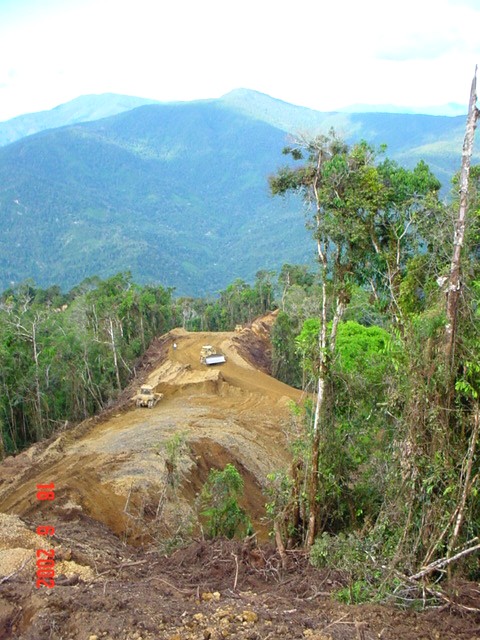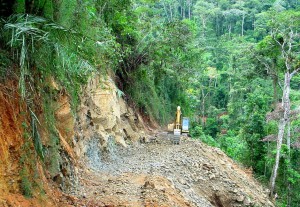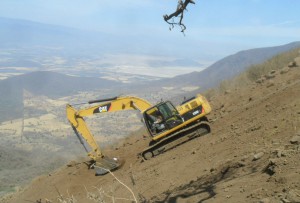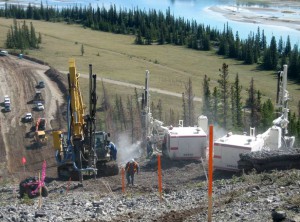January 2015, Vol. 242, No. 1
Features
Challenges Facing Large-Diameter Pipelines Crossing Mountains

Canadian hydrocarbon production is growing and the nation is looking to pursue offshore markets as an important element of a strategy for expanded oil and natural gas sales.
Numerous tidewater locations for hydrocarbon export facilities are to be found on Canada’s West Coast, however, transmission pipeline infrastructure from principal producing areas in Alberta and northeastern British Columbia is limited, hampering transportation of large volumes of oil and natural gas to possible port locations.
Although technical and commercial risks associated with any major pipeline project are significant, recent technological advances in techniques are creating greater economic incentives for operators and producers to promote transmission pipeline projects through the mountainous regions of Western Canada. Whether transporting oil or gas, economic barriers once associated with the development of new pipeline infrastructure are now seen in a different light.
Construction Challenges
Route selection is typically driven by the shortest, most cost-effective path between an energy source location and a marine facility. Routes are often selected to be in close proximity to existing transportation infrastructure or utility corridors.

However, this approach must be re-evaluated as the principal routing drivers on many large-diameter mountain projects will face significant geo-hazards or other terrain features that dictate a longer, safer route that is buildable and cost-effective. Additionally, community relations and other “social license” considerations will play a major role in route selection in many areas.
Regulatory agencies typically impose conditions on a project that can affect both pipeline design and construction execution. This may result in a narrower than desired right-of-way to minimize environmental disruption. A right-of-way that is too narrow may hinder safe construction.
A second likely condition may involve regulatory approval concerning potential disruption to wildlife migration and breeding patterns, resulting in distinct restricted access periods (RAPs). These constraints will often reduce the number of spread production days available during seasonal construction periods.
Due to the remote location of most large-diameter mountain projects, there typically is a lack of existing transportation infrastructure to adequately support construction. Much of the daily transportation between work camp locations and the right-of-way will likely occur on forestry service roads (FSRs), short temporary roadways and along the pipeline right-of-way itself.

Right-of-way characteristics and frequency of watercourse crossings may constrain the travel lane of the right-of-way resulting in the need for a greater number of temporary roadways to be built. In some cases, less efficient travel along the right-of-way may lessen environmental impact, be cost less and prove more advantageous from a scheduling standpoint than building roads.
Long lead times are often required for the purchase of work camp facilities, typically due to the size and number of camps needed for a multi-spread, multi-season, large-diameter pipeline construction program. Often, demand for large volumes of camp facilities overlap between projects (other pipeline and infrastructure development), resulting in competition for limited supply. In such cases, early commitments must be made to manufacturers of camp modules due to the often long procurement cycle for these facilities.
During the construction execution planning stage, an inventory of existing access roads and bridges in the vicinity of the pipeline alignment should be prepared. The current condition of these must be surveyed and the work required noted. The need for roads will be identified as part of an early work-construction program.
Installation of some complex or otherwise problematic crossings such as tunnel, aerial or challenging watercourse crossings may be scheduled concurrently with an early works program due to the time involved for both the design engineering and regulatory permitting activities that may be required.
Most mountain projects will involve many trenchless crossing installations. Some of these will be installed out of sequence with the main cross-country pipe installation activities so as to provide schedule risk insurance for these more problematic crossings.
Some aspects of right-of-way preparation will also be part of the early works program. Clearing and timber salvage will typically be performed a season in advance of pipe installation work. In areas of heavy rock grade this work, too, may often be performed a season in advance of pipe installation.
When traversing terrain such as in the Rocky or Coast Mountain ranges, large volumes of both grade and ditch rocks are anticipated. During the construction execution planning stage, when determinations are being made about the locations and dimensions of temporary and extra work spaces, rock spoil storage and other temporary workspace needs must be factored into the calculations.
Pipe Installation
Many contemporary pipeline projects are being subjected to pressures arising from community consultation initiatives and rigorous regulatory review processes that limit project footprints.
The result often affects construction safety, especially when working in a mountainous environment, and certainly lowers overall spread production rates. While a constricted workspace will be detrimental to production rates, the most important consideration must be safe work practices.

In extreme longitudinal slope conditions in which use of a pipelayer may not be practical or safe, an aerial cable-way system – sometimes referred to as a “highline” – or helicopter may be necessary to string pipe.
Weather affects schedules, and cost allowances are typically estimated during the construction execution planning phase of a pipeline project. Potentially more severe weather conditions can be encountered at higher elevations and must be accounted for as part of the execution planning work.
Higher elevations encountered with mountain crossings can be subject to heavy snowfall and the risk of avalanches down steep valley slopes. Consideration should be given to scheduling most construction activities in higher elevation areas most susceptible to avalanche and geo-hazard risk during summer seasons.
The primary challenge for bending crews will be the number of cold field bends made and the time needed for each. The likely approach to bending for large-diameter, heavy wall transmission oil and gas pipelines traversing mountains is to equip a spread with multiple bending crews so as to keep production at a pace that will not hamper welding production operations that follow.
Typically, the engineering design for a mountain project will result in of a higher than normal number of factory bends, compared to a pipeline of similar design traversing the prairies.
The average number of mainline production welds made each day will vary significantly between spreads and often between sections within a given spread. The planned production welding rate is largely dependent on the number of river, road and other crossings encountered on the spread, as well as the topography along the graded right-of-way.
Most cross-country transmission pipelines in Canada involve large-diameter pipe. Production welding for such lines typically requires a mechanized welding system. Execution plans typically involve smaller “poor boy” welding crews for a mountain spread. In extreme slope conditions, pipe joints may be welded in the ditch one joint at a time. This procedure is referred to as “stove piping.”
As a general rule, regardless of the welding technique or method selected, the average daily welding production rates are expected to be significantly lower when crossing mountainous terrain due to the steep slope conditions, limited right-of-way access and severe weather.
Rock ditch conditions will result in the specification of special pipe mechanical protection coatings. Such coatings might include factory-applied products or field-applied pipe protection systems. The typical use of rollie-cradles attachments for pipelayers on the lowering-in crew may have to be replaced by slings when such coatings are used. This reduces the pace at which pipe strings can be lowered into the ditch.
In rock ditch conditions, pipe corrosion coating and mechanical protection is often enhanced with the placement of bedding material, foam pillows or sand bags. Any measures to ensure pipe protection adds to production rates.
Pressure testing of pipelines is typically achieved by hydrostatic methods using water as the test medium. In some instances, changes in elevation are drastic and occur over relatively short distances.
The large number of test sections on a mountain spread will challenge contractors’ abilities to complete the work within the time constraints of relatively short seasonal construction periods. A likely outcome will be the need to engage multiple test crews to complete this work on schedule.
Safe operation in steep terrain often requires tethering of the unit to a stable “anchor point” through a winch cable system. In terms of the mechanical operation of the heavy equipment, special attention must be given to lubricating fluids, which must be closely monitored, especially in locations with steep slopes.
When working on side slopes there are safety risks on the upslope and downslope of the right-of-way. Barriers may be to protect workers from rock fall and debris flow.

In locations along the right-of-way with very steep slopes, winching of equipment will be required. Rollover protection systems (ROPS) will be needed for most machine types used on a mountain spread.
Construction Risks, Costs
Pipeline spread length is generally determined by the estimated average daily production rate that a spread is expected to achieve for a given set of project parameters: pipe specification, route and terrain characteristics, including the extent of existing access in the region and season of construction.
Most major pipeline projects proposed to move oil or gas to the west coast of British Columbia are expected to involve multi-spread, multi-season configurations. Early contractor involvement in establishing an optimum spread configuration is recommended.
The continuity of work along a given spread and between seasonal spreads within a contract package is an important consideration. The cost and schedule consideration is especially critical for spreads requiring camp support facilities.
Many mountain spreads will require main camps of 800 to 1,000 beds, along with a number of smaller camps used for initial clearing and early right-of-way preparation work, as well as any significant out-of-sequence work relative to the main pipe installation activities.
Due to the polarizing debate surrounding further development of Alberta’s oil sands and new development of tight oil and gas reserves by way of fracking, climate change and a variety of other social and geopolitical issues, pipeline projects across North America have become a focal point for criticism from a broad spectrum of the general public.
While it is imperative for pipeline operating companies to earn the appropriate “social license” for projects, failure to completely do so may result in acts of civil disobedience at or near worksites during construction. The potential of such disruptions should be part of overall project contingency calculations.
The greatest chance of success for any construction project involves proper assessment of all potential execution risks. This includes identifying and assessing appropriate mitigation measures. One of the greatest cost uncertainties involves anticipating market conditions that might affect the supply of specialized pipeline construction services. The basic principles of supply and demand come sharply into focus when peaks in construction services demand put pressure on a limited supply of resources.
Even with the adoption of the latest technologies and equipment such as the automation of some equipment and processes, large elements of construction schedule and cost performance relate to the skill and experience of lead tradesmen and the field supervisory staff supplied by pipeline construction contractors. With many large-scale projects planned for construction on similar timelines, these key personnel will form the bulk of the potential labor resource shortfall.
Fortunately, there has been a good level of work activity in the Canadian pipeline construction market in recent years, and this is expected to continue until the proposed start of construction for many of the large projects to the coast planned for British Columbia. This level of activity will help to provide more training and experience for pipeliners in general, and especially for the contractors’ field supervisory staffs to the crew foreman level.
As with most industries, pipeline construction requires the use of a great deal of specialized equipment, such as pipelayers, bending machines and boring machines. Many other units of construction equipment used are not exclusive, such as excavators, dump and rock trucks, dozers, and support vehicles.
The urgency to source the more common type of equipment before construction on a significant mountain project may be more important than lining up specialized pipeline equipment. This is especially true if heated market conditions are encountered as a result of a significant imbalance in the supply and demand of pipeline construction services capacity.
The level of market activity in the sector often dictates how aggressively pipeline operating companies approach their construction contracting strategy.
At a high level, two important goals for project proponents are first, to ensure there is sufficient construction services capacity available to execute on the proposed project timeline; and second, to achieve an acceptable degree of schedule and cost certainty prior to the start of construction.
The first goal can be achieved by engaging one or more pipeline construction contractors through master services agreements. The second goal is more difficult because project proponents are often unable to provide an adequate level of project definition to offer firm pricing and guarantee on-schedule performance.
Execution Planning
Pipeline construction in mountainous terrain will require comprehensive execution planning well before construction begins. Some of the challenges illustrated in this article would not typically be considered during the planning process for a prairie or other “flatland” pipeline project. Operating companies are well-advised to identify pipeline construction contractors much earlier during the project execution planning process in order to integrate contractors into the engineering design and regulatory project teams.
Critical constructability input will help to mature project definition. In turn, this will provide a greater degree of schedule and cost certainty with an eye toward project success.
Lastly, early contractor involvement will allow contractors to upgrade or expand equipment fleets in time to be prepared for some of the special challenges posed by a large-diameter pipeline project that crosses mountainous terrain.
Authors: David P.A. Hermanson has more than 15 years of direct experience in oil and gas pipeline construction working for contractors, owner companies and EPCMs in a variety of roles. He is involved in the planning of an interprovincial pipeline project to the west coast of Canada.
Michael J. Wagner is a senior engineering and construction executive with more than 44 years of experience in the oil and gas industry. He has been involved in the start-up and expansion of major pipeline construction companies throughout North America and in the completion of large-diameter pipeline projects in the United States and Canada, as well as Malaysia, Brazil, Bolivia, and Trinidad and Tobago.





Comments